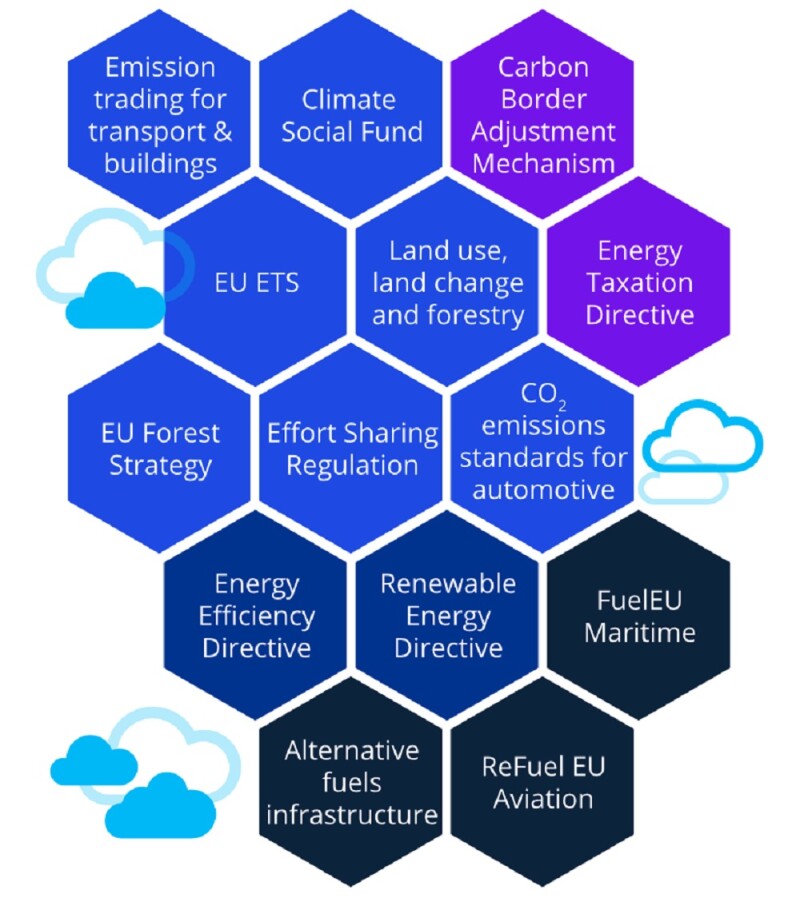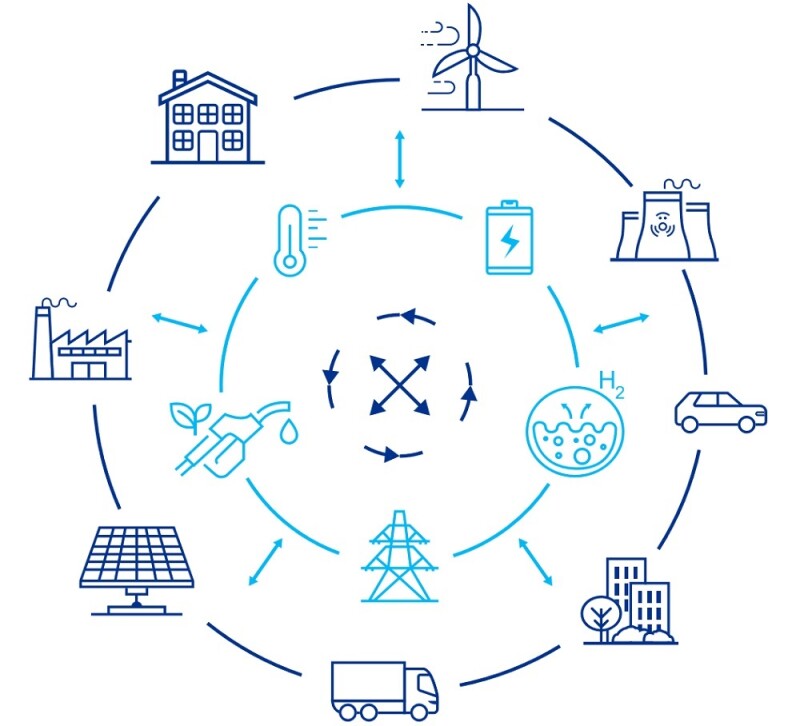The EU is forging ahead with its plans to make Europe the first climate-neutral continent by 2050, after the European Parliament voted on the energy efficiency and renewable energy directives on September 14 2022.
Setting the scene
The European Commission presented its ‘Fit for 55’ package in July 2021, which includes draft climate, energy, and transport-related legislation intended to align EU laws with its 2030 target of cutting greenhouse gas (GHG) emissions by at least 55% in 2030 compared with 1990 levels and its 2050 ambition.
The package consists of a set of 14 legislative proposals, with five key elements:
Tougher EU emissions caps for power plants and factories;
Stricter national limits on GHG from non-Emissions Trading System sectors;
Stricter EU caps on CO2 emissions from cars;
Renewable energy; and
A Carbon Border Adjustment Mechanism (CBAM).
Within these proposals is the revision of two significant energy directives; namely, the Energy Efficiency Directive (EED) and the Renewable Energy Directive (RED).
The Fit for 55 package

Fit for 55 focuses on specific topics that need particular attention and a strong green transition to achieve climate neutrality.
Principles of the EED and RED
Energy is at the heart of the climate neutrality transition, and the ‘energy efficiency first’ principle is at the heart of EU energy policy.
In 2012, an EED established a set of binding measures to help the EU to meet its energy efficiency target by 2020, whereby all EU countries are required to use energy more efficiently at all stages of the energy chain, including energy generation, transmission, distribution, and end-use consumption.
In 2018, the policy framework was updated, with a key element being a headline energy efficiency target (i.e., a reduction in energy consumption, where ‘energy’ means all forms of energy products, combustible fuels, heat, renewable energy, electricity, or any other form of energy) for 2030 of at least 32.5% (compared with projected energy use in 2030). In absolute terms, this means that EU energy consumption should be no more than 1,128 million tonnes of oil equivalent (Mtoe) of primary energy and/or no more than 846 Mtoe of final energy for the 27 member states of the EU. The total annual EU energy consumption target was 1,483 Mtoe and 1,086 Mtoe in primary and final energy respectively under the 2012 directive for the 28 member states.
Under the Fit for 55 package, the European Commission put forward a proposal for a recast of the EED that nearly doubles the annual energy saving obligation. The EED also offers multiple provisions to speed up the efforts to drive energy efficiency, including:
Stepping up actions and addressing gaps for energy efficiency;
New rules for cutting energy consumption by public buildings;
Higher yearly energy savings obligations by members;
Measures to protect vulnerable consumers;
Revising metering and billing provisions for thermal energy; and
Improving efficiency in heating and cooling.
Additionally, the transition to cleaner forms of energy is a prerequisite for climate neutrality. A 2009 directive on the promotion of the use of renewable energy sources, RED I, set minimum binding national targets for all member states in respect of the share of renewable energy in the EU as a percentage of gross final consumption of energy. The minimum targets, which varied between member states, collectively ensured that the overall EU-level target of 20% would be met. In 2018, this objective was raised to an overall target of 32% by 2030 under RED II.
The revision of RED II (RED III) is designed to reflect the more ambitious goals of the 2030 climate and energy frameworks and establish a common system to promote energy from renewable sources across different sectors. Innovative measures will be introduced to exploit all possible renewable energy development opportunities, which include the following:
Specific targets proposed for renewable energy use in transport, heating and cooling, buildings, and industry, with increasing focus away from classic renewable energy sources (e.g., solar and wind) to new types of energy (e.g., hydrogen, biofuels, and other renewable fuels) (the table below includes some of these proposed targets).
Convert into EU law some of the concepts outlined in the energy system integration and hydrogen strategies (e.g., integrated energy systems). The energy system is built on several parallel, vertical energy value chains, which rigidly link specific energy resources with specific end-use sectors. Energy system integration encompasses three complementary and mutually reinforcing concepts: (i) a more ‘circular’ energy system (e.g., re-using waste heat); (ii) a greater direct electrification of end-use sectors (e.g., using heat pumps for space heating); and (iii) the use of renewable and low-carbon fuels, including hydrogen, for end-use applications where direct heating or electrification is not feasible, not efficient, or has higher costs (e.g., using synthetic fuels produced from renewable electricity in aviation and maritime transport).
Biomass, especially the use of wood, will no longer be supported by the European Commission. Instead, it will be included in specific prohibitions in national incentives.
To support renewables deployment, member states will remove barriers to permitting procedures and power purchase agreements and further develop work on guarantees of origin.
Together, the recast of the EED and revision of the RED is intended to increase the share of renewables in the energy mix and meet enhanced energy efficiency targets through integrated energy systems.

Future EU integrated energy system: energy flows between users and producers, reducing wasted resources and energy. See here for further information.
According to the EU strategy on energy system integration, “Sector integration means linking the various energy carriers – electricity, heat, cold, gas, solid and liquid fuels – with each other and with the end-use sectors, such as buildings, transport or industry. Linking sectors will allow the optimisation of the energy system as a whole, rather than decarbonising and making separate efficiency gains in each sector independently. The new EU strategy will involve various existing and emerging technologies, processes and business models, such as ICT and digitalisation, smart grids and meters and flexibility markets.”
A successful outcome
The European Commission presented the proposals for the recast and revision of the directives on July 14 2021. The Council of the EU approved the general approach of these proposals, and after the Committee reports on the recast of the EED and revision of the RED were presented to the entire European Parliament, members of the European Parliament voted on both reports on September 14 2022. These reports, with amendments, were adopted and will be taken to the EU member states for further negotiation.
The proposals join nine of the fourteen proposals that have already made their way into the end stages of legislative procedure, being trialogue negotiation, before approval in plenary and subsequent adoption. See KPMG Global’s Fit for 55 mid-July 2022 legislative update for further details.
At the time of writing, the European Commission, the European Parliament, and the Council of the EU (representing all member states) have entered into trialogue negotiations to find common ground on the different positions that have been taken by each of the three parties on different elements of the directives. The most significant aspects to be agreed upon, and the different positions adopted by each party, are summarised as follows:
Fit for 55 package proposal | Topic | European Commission proposal | EU parliamentary position | Council position |
EED | Binding EU-level target: Energy consumption reduction | Energy savings targets: 40% of final energy consumption; and 42.5% of primary energy consumption (increased from 36% and 39% respectively as part of the REPowerEU plan). | Agree with European Commission proposal of increased targets of 40% and 42.5%. | Reduction of energy consumption at EU level: 36% for final energy consumption; and 39% for primary energy consumption by 2030. The key target of a 36% reduction at EU level for final energy consumption would be binding. |
Binding member states’ cumulative target | Energy savings target for final energy consumption: At least 0.8% of annual final energy consumption up to December 31 2023; and At least 1.5% as of January 1 2024. | Energy savings target for final energy consumption: At least 0.8% of annual final energy consumption up to December 31 2023; and At least 2% as of January 1 2024. | Gradual increase of the energy savings target for final energy consumption: 1.1% of annual final energy consumption from January 1 2024; 1.3% from January 1 2026; and 1.5% from January 1 2028 to December 31 2030, with the possibility to carry over a maximum of 10% of excess savings to the following period. | |
Public sector – annual reduction of energy consumption | Annual reduction of at least 1.7%. | Annual reduction of at least 2%. | Annual reduction of: 1.7%; or At least 1.9% each year if excluding public transport or armed forces. Member states required to renovate each year at least 3% of the total floor area of buildings owned by public bodies. | |
Data centres | Owners and operators of every data centre with a significant energy consumption to publish information on their energy consumption every year from March 15 2024. | Owners and operators of every data centre with an installed IT power demand equal to or greater than 100 kW consumption to publish information on their energy consumption every year from March 15 2024. | Agree with European Commission proposal. | |
Addition not in proposal – fossil fuel combustion technologies | Direct fossil fuel combustion technologies can be included to achieve the cumulative end-use energy savings required (provided they comply with the most up-to-date corresponding EU emission performance legislation and are compatible with climate-neutral renewable energy sources, alternative fuels, and technologies. | Possibility to include energy savings realised through fossil fuel combustion technologies in the industrial sector only, in duly justified cases, in the calculation towards the target. | ||
RED | Binding EU-level target | 45% of energy from renewable sources in the overall energy mix by 2030 (increased from 40% as part of the REPowerEU plan). | 45% of energy from renewable sources in the overall energy mix by 2030. | 40% of energy from renewable sources in the overall energy mix by 2030. |
Sub-targets for transport | 13% reduction in carbon intensity of transport fuel by 2030. | 16% reduction in carbon intensity of transport fuel by 2030 (gradually increased, starting from 6% in 2021). | Possibility for member states to choose between: A binding target of 13% GHG intensity reduction in transport by 2030; or A binding target of at least 29% renewable energy within the final consumption of energy in the transport sector by 2030. | |
Sub-target for advanced biofuels supplied to the transport sector | At least: 0.2% in 2022; 0.5% in 2025; and 2.2% in 2030. | At least: 0.2% in 2022; 1% in 2025; and 2.6% in 2030. | 0.2% in 2022; 1% in 2025; and 4.4% in 2030, integrating the addition of a double counting for these fuels. | |
Sub-target for renewable fuels of non-biological origin in transport | At least 2.6% in 2030. | Agree with European Commission proposal. | Agree with European Commission proposal. | |
Heating and cooling | Average minimum annual increase of 1.1% in the share of renewable sources by 2030. | Agree with European Commission proposal. | Gradual increase in renewable targets for heating and cooling, with a binding increase of 0.8% per year at national level until 2026 and 1.1% from 2026 to 2030. | |
Hydrogen | 50% of the hydrogen used in industry should come from renewable fuels of non-biological origin by 2030. | 50% of the hydrogen used in the hard-to-abate high-temperature industry, aviation, and shipping sectors, where electrification is not a feasible solution, should come from renewable fuels of non-biological origin by 2030. | 35% of the hydrogen used in industry should come from renewable fuels of non-biological origin by 2030 and 50% by 2035. | |
Buildings | Non-binding target of 49% share of energy from renewable sources in the buildings sector in 2030. | Agree with European Commission proposal. | Agree with European Commission proposal. | |
Cross-border projects | By December 31 2025, each member state will agree to establish at least one joint pilot project with one or more other member states for the production of renewable energy. | By December 31 2025, each member state shall agree to establish at least two joint pilot projects with one or more other member states for the production of renewable energy. Member states with an annual electricity consumption of more than 100 TWh will have to develop a third one by 2030. | Agree with European Commission proposal. | |
Additions not in proposal | The rollout of hybrid heat pumps that can use heat as an energy source as well as gas should be incentivised within the Renewable Energy Directive criteria to achieve the 2030 and 2050 climate targets. | Cap to the amount of final consumption of energy in the maritime sector to be included in the calculation of its transport targets. Fast-track the deployment of renewable energies through the accelerated permitting procedures for renewable energy projects in line with the priorities of the REPowerEU plan as proposed by the European Commission in May 2022. |
What this means for organisations – next steps
While it may take some time for the legal process to run its course (once adopted by Parliament, there is still an additional period during which member states must transpose this EU legislation into national laws), the directives will require the rapid and equal expansion of renewable energies and energy efficiency measures.
The energy crisis and the war in Ukraine make these changes all the more urgent.
Although progress in the uptake of renewables across economic sectors has so far been mixed, RED III aims at pushing higher shares of renewables in various sectors: transport, heating and cooling, buildings, and industry. Crucially, by making energy savings a legal obligation on member states, the reduction of energy consumption across all sectors will be a focus area, albeit through different improvement measures, as member states will retain full flexibility in determining how the targets will be achieved.
Global climate actions only continue to intensify, and businesses should begin assessing what the legislative changes mean for their operations, whether it be sourcing energy from alternative suppliers, developing storage technologies, insulating buildings, or preparing for energy audits.
How KPMG professionals can help
KPMG firms have developed a leading global climate change and decarbonisation practice. Working alongside environmental, social, and governance (ESG) tax and legal teams, they deliver leading approaches as they work collaboratively with clients on the journey to a low-carbon future.
KPMG ESG professionals can assist you with a climate risk and decarbonisation strategy that includes helping you to gain strategic foresight and operational value in your decarbonisation journey, from emissions measurement to implementation, monitoring, and reporting. All this is supported by an array of options – such as renewable energy procurement, energy efficiency, a circular economy, and supply chain management – and includes assessing and understanding the underlying tax and legal impacts.


















